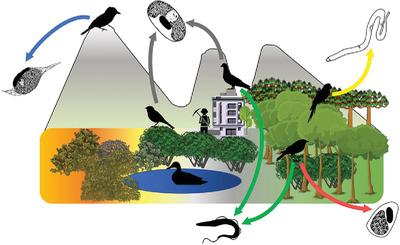当前位置:
X-MOL 学术
›
Integr. Zool.
›
论文详情
Our official English website, www.x-mol.net, welcomes your feedback! (Note: you will need to create a separate account there.)
Bird habitat preferences drive hemoparasite infection in the Neotropical region
Integrative Zoology ( IF 3.3 ) Pub Date : 2021-01-16 , DOI: 10.1111/1749-4877.12515 Gabriel Massaccesi DE LA Torre 1, 2 , Karla Magalhães Campião 1
Integrative Zoology ( IF 3.3 ) Pub Date : 2021-01-16 , DOI: 10.1111/1749-4877.12515 Gabriel Massaccesi DE LA Torre 1, 2 , Karla Magalhães Campião 1
Affiliation

|
The role that the environment plays in vector-borne parasite infection is one of the central factors for understanding disease dynamics. We assessed how Neotropical bird foraging strata and habitat preferences determine infection by parasites of the genera Haemoproteus, Plasmodium, Leucocytozoon, and Trypanosoma and filarioids, and tested for phylogenetic signal in these host–parasite associations. We performed extensive searches of the scientific literature and created a database of hemoparasite surveys. We collected data on host body mass, foraging strata, habitat preference, and migratory status, and tested if host ecological traits predict each hemoparasite occurrence and prevalence using a phylogenetic Bayesian framework. Species of Plasmodium tend to infect birds from tropical forests while birds from altitudinal environments are likely to be infected by species of Leucocytozoon. The probability of a bird being infected by filarioid or Trypanosoma is higher in lowland forests. Bird species that occur in anthropic environments and dry habitats of tropical latitudes are more susceptible to infection by species of Haemoproteus. Host foraging strata is also influential and bird species that forage in the mid-high and canopy strata are more prone to infection by species of Haemoproteus and filarioids. We also identified phylogenetic signal for host–parasite associations with the probability of infection of Neotropical birds by any hemoparasite being more similar among more closely related species. We provided a useful framework to identify environments that correlate with hemoparasite infection, which is also helpful for detecting areas with potential suitability for hemoparasite infection due to land conversion and climate change.
中文翻译:

鸟类栖息地偏好导致新热带地区的血液寄生虫感染
环境在媒介传播的寄生虫感染中所起的作用是了解疾病动态的核心因素之一。我们评估了新热带鸟类觅食地层和栖息地偏好如何决定血变形虫属、疟原虫属、白细胞动物属和锥虫属寄生虫的感染。和丝虫,并在这些宿主 - 寄生虫关联中测试系统发育信号。我们对科学文献进行了广泛的搜索,并创建了一个血液寄生虫调查数据库。我们收集了有关宿主体重、觅食地层、栖息地偏好和迁徙状态的数据,并使用系统发育贝叶斯框架测试宿主生态特征是否能预测每种血寄生虫的发生和流行。疟原虫物种倾向于感染来自热带森林的鸟类,而来自海拔环境的鸟类可能会被白细胞动物物种感染。鸟类感染丝虫或锥虫的概率在低地森林中更高。出现在人类环境和热带纬度干燥栖息地的鸟类物种更容易受到Haemoproteus物种的感染。宿主觅食地层也有影响,在中高层和树冠层觅食的鸟类更容易受到血形线虫和丝虫的感染。我们还确定了宿主 - 寄生虫关联的系统发育信号与任何血液寄生虫感染新热带鸟类的可能性在更密切相关的物种中更相似。我们提供了一个有用的框架来识别与血液寄生虫感染相关的环境,这也有助于检测由于土地转换和气候变化而可能适合血液寄生虫感染的区域。
更新日期:2021-01-16
中文翻译:

鸟类栖息地偏好导致新热带地区的血液寄生虫感染
环境在媒介传播的寄生虫感染中所起的作用是了解疾病动态的核心因素之一。我们评估了新热带鸟类觅食地层和栖息地偏好如何决定血变形虫属、疟原虫属、白细胞动物属和锥虫属寄生虫的感染。和丝虫,并在这些宿主 - 寄生虫关联中测试系统发育信号。我们对科学文献进行了广泛的搜索,并创建了一个血液寄生虫调查数据库。我们收集了有关宿主体重、觅食地层、栖息地偏好和迁徙状态的数据,并使用系统发育贝叶斯框架测试宿主生态特征是否能预测每种血寄生虫的发生和流行。疟原虫物种倾向于感染来自热带森林的鸟类,而来自海拔环境的鸟类可能会被白细胞动物物种感染。鸟类感染丝虫或锥虫的概率在低地森林中更高。出现在人类环境和热带纬度干燥栖息地的鸟类物种更容易受到Haemoproteus物种的感染。宿主觅食地层也有影响,在中高层和树冠层觅食的鸟类更容易受到血形线虫和丝虫的感染。我们还确定了宿主 - 寄生虫关联的系统发育信号与任何血液寄生虫感染新热带鸟类的可能性在更密切相关的物种中更相似。我们提供了一个有用的框架来识别与血液寄生虫感染相关的环境,这也有助于检测由于土地转换和气候变化而可能适合血液寄生虫感染的区域。



























 京公网安备 11010802027423号
京公网安备 11010802027423号